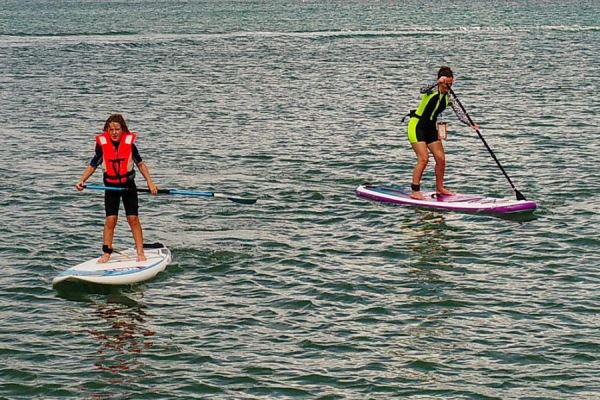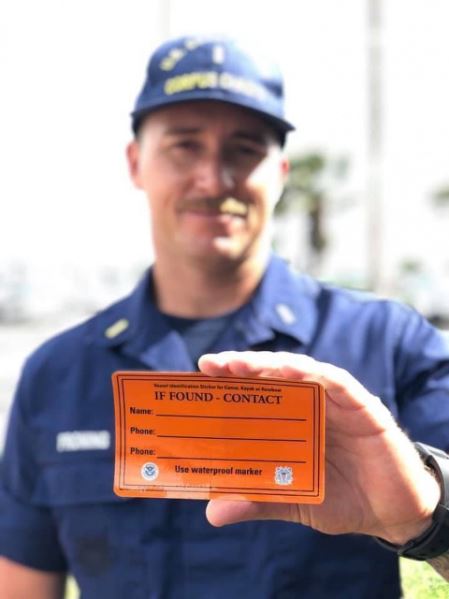 As most boaters know stand-up paddleboarding has grown more popular with each passing season, and even if you don’t participate yourself, often they and related gear are carried aboard a boat for kids and guests. Those engaging in this fun pasttime (plus rallies, regattas and ‘cruises’ just as traditional boaters), have integrated the activity in practically all our waters; in calm lakes, bays, rivers and reservoirs, to whitewater surfing, to paddleboarding in surf breaks and the open ocean, and often the Great Lakes.
As most boaters know stand-up paddleboarding has grown more popular with each passing season, and even if you don’t participate yourself, often they and related gear are carried aboard a boat for kids and guests. Those engaging in this fun pasttime (plus rallies, regattas and ‘cruises’ just as traditional boaters), have integrated the activity in practically all our waters; in calm lakes, bays, rivers and reservoirs, to whitewater surfing, to paddleboarding in surf breaks and the open ocean, and often the Great Lakes.
There are certain legal requirements and issues related to safety that some may be unaware. The Coast Guard’s Office of Auxiliary and Boating Safety in Washington has determined that when beyond the narrow limits of say a swimming or bathing area, a SUP is subject to the application of federal regulations for vessels. (And ignorance of the law is no excuse, or a defense.)
Deemed ‘Vessels’ / Life Jackets
Stand-up paddleboards (SUPs) are also deemed a “vessel” for purposes of carrying a readily accessible personal flotation device. There is an exemption though while in the surf zone of a lake or the surf zone of an ocean, or very near to shore.
Many paddlers do wear a life jacket on the board since if falling off and if you're not wearing an appropriate leash, you are in the water without any flotation device or connection to your board. Naturally unlike a canoe or kayak that fills up with water when capsized, a SUP will simply keep drifting away even if only minimal wind or a slight current.
However an expert and senior instructor with the American Canoe Association also notes there are two challenges to PFD (and leash wear) for SUPers. It can be dangerous to wear a life jacket in surf, and wearing a leash in moving water or a swift-flowing tidal river could also be extremely hazardous. Good swimmers actively surfing in the ocean would not allow you to dive underneath waves once you have fallen off the board – plus would keep your head on the surface right next to the board's sharp fins.
Paddleboarders must be mindful too of local and specific area rules. Authorities advise that wearing a PFD is a wise decision in most water venues, and most states require children 12 and under actually wear a PFD.
There are complexities concerning leash wear. Although very important in some waters, authorities advise it is not prudent to simply make a blanket statement regarding leashes.
It is a widely accepted view that SUPs use coiled leashes on lakes and straight leashes in the ocean, however a more challenging situation is presented in tidal and inland rivers with swift-moving water. What if you fall ff your board and it goes around a dock piling on one side while you go around the other, or the leash snags on a branch or other obstacle? Wearing a leash could quite obviously be extremely dangerous. Or in another scenario, starting out in a lake and then must paddle through a meandering river or estuary to reach the next lake. That person or persons would need to know that a coiled leash appropriate for lake use but necessary to remove or wear a quick-release leash for the moving water river or estuary section to avoid potential entrapment hazards.
Even though there are a range of quick-release leashes that attach to your torso area, notes the American Canoe Association (the oldest non-profit paddlesports organization in the U.S. by the way), they too should only be worn in certain waters. For example, if a river is shallow or rocky, or if there are a lot of potential snagging hazards from trees or debris, it is not generally recommended to wear any type of leash. But if the river is deep, fast-flowing, and free from obstructions, a quick-release leash attached to your torso might be prudent. If falling into that river or tidal environment, you could quickly be separated from your board and have a long swim or where no one else is nearby to help. Even so, in that environment there are still risks say the experts with wearing a leash.
Association (the oldest non-profit paddlesports organization in the U.S. by the way), they too should only be worn in certain waters. For example, if a river is shallow or rocky, or if there are a lot of potential snagging hazards from trees or debris, it is not generally recommended to wear any type of leash. But if the river is deep, fast-flowing, and free from obstructions, a quick-release leash attached to your torso might be prudent. If falling into that river or tidal environment, you could quickly be separated from your board and have a long swim or where no one else is nearby to help. Even so, in that environment there are still risks say the experts with wearing a leash.
Education is critical to learn what is the appropriate leash for what venue – when to wear a leash and what type for where you paddle – along with life jacket wearing situational recommendations. Your proper use of pieces of equipment (including a whistle or other sound signal that must be carried) is of the utmost importance. And see www.americancanoe.org for information on selecting also the proper board for a user's weight and experience.
U.S. Army Corps of Engineers
Some paddleboarders may not realize that the USACE is the nation's largest provider of water-based recreation on public lands and it has implemented mandatory life jacket wear in some areas for all non-powered ‘vessels’ regardless of length.
Particular individual states that may require life jacket wear (children of a certain age and under) and where there are cold water areas thus you must be mindful of that and check with your marine patrol or Power & Sail Squadron organization.
Another state could require paddleboarders with 'crafts' longer than 10 feet obtain an aquatic invasive species permit. Some may conflict with USCG rules like Minnesota. While surfing in surf break areas in Lake Superior for instance you would need to either wear or have a life jacket on the board. The Minnesota Department of Natural Resources Boating Guide outlines its regulations. For Wisconsin check with the Wisconsin DNR at www.dnr.wi.com and regularly check where you stand-up paddleboard for rules, and updates.
Illinois SUP users are advised to check with agencies having jurisdiction over specific areas for obtaining a user sticker or tag or other requirements.
Local ordinances should be checked too to be SUP smart, and safe.
Most marine insurers don’t cover them as a dinghy or ‘boating equipment’ (typically defined as something regularly carried aboard for a boat’s safe operation or routine maintenance). Some insurers might consider it a Personal Effect, like a canoe or kayak, but only covered while actually on the boat, or being loaded or unloaded from the insured boat, and not while on the water. Check with your insurer.
Newer Paddleboarders / Checklist
Know:-the various parts of the paddleboard and setting up
-how to stand up properly
-how to handle your board, paddling and turning
Joan Wenner, J.D. is a longtime boating safety writer with a law degree and regularly contributes to major boating publications including GREAT LAKES BOATING. Questions or comments are welcomed at joan_writer@yahoo.com